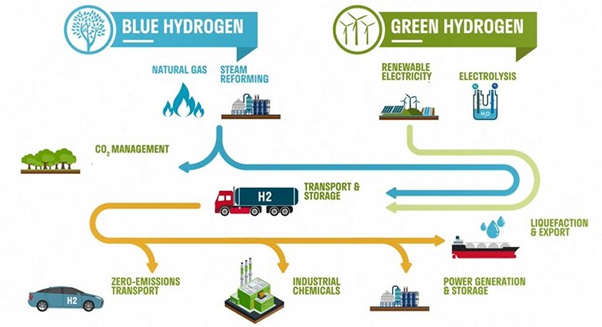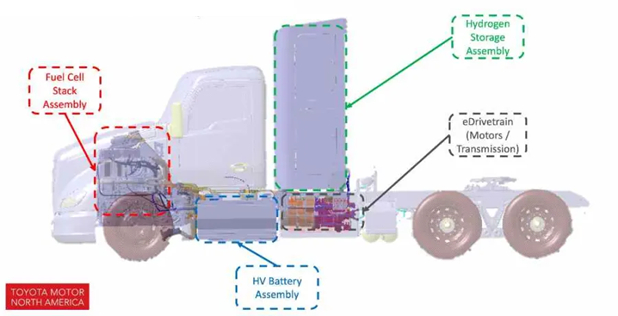Hydrogen is the earth’s most abundant element and has a massive potential to decarbonise many energy sectors despite the challenges associated with the energy transition. Hydrogen can be produced from renewable energy, generating zero emissions when utilised, and will play a fundamental role in achieving the Paris Agreement targets.
Hydrogen can be stored in multiple ways in both small and large quantities, as a gas or liquid.
Hydrogen can be safely transported in a variety of ways, including pipelines, trucks or ships. This practicality of carrying Hydrogen as a gas allows it to be used in domestic applications and exported overseas, making it a traded green energy commodity.
Zero Emissions
Greenhouse emissions are not generated when utilising green Hydrogen in different applications, making it a climate-friendly energy source. Unlike fossil fuel sources, green Hydrogen reduces pollution and improves air quality.
What makes green hydrogen ‘green’?
It has been a standard practise for industrial processes to use Hydrogen from fossil fuels as a chemical feedstock, requiring heat and chemical reactions to release the Hydrogen from organic materials. This process releases harmful carbon emissions into the atmosphere contributing to climate change.
Nowadays, there are different processes to reduce or eliminate these emissions. Green Hydrogen, for example, is produced from water by splitting Hydrogen and oxygen molecules with an electric current. The equipment required for this process is known as an electrolyser, and the electricity to power it must come from renewable energy to produce green Hydrogen. As a result, it is a zero-emissions process.
This is how we come to all the different shades of Hydrogen:
New alternative processes for producing hydrogen have emerged in recent years. Therefore, a colour code for hydrogen identification has been set according to its production method. Some of the most known colours are described below.
- Brown hydrogen is produced using coal, which releases emissions into the atmosphere.
- Grey hydrogen is produced from natural gas, and the associated emissions are released into the atmosphere.
- Blue Hydrogen is produced from natural gas, but the emissions are captured and stored using a Carbon Capture and Storage (CCS) process.
- Green Hydrogen is produced from water using an electrolyser powered by renewable electricity and does not generate emissions.
Note that green and blue Hydrogen are the only options that do not generate carbon emissions into the atmosphere. They can be used in many industries to replace fossil fuels to create a more environmentally friendly and sustainable economy.

A comparison of the production process for the “blue” and “green” types of Hydrogen.(Supplied: Woodside)
What does it mean for the Heavy Fleet Industry?
As the shift to renewable energy gathers momentum, industries of the world are going green, and the heavy fleet industry is no exception––the future of haulage is Hydrogen.
Countries all across the globe are enacting rules to minimise emissions and achieve their environmental goals of net zero emissions by 2050. Therefore, industries will have to transition towards clean technologies with green energy sources.
What is a fuel cell in a truck?
FCEVs use a system similar to that of electric vehicles, where energy stored as Hydrogen is converted to electricity by the fuel cell.
Fuel Cells only utilise Hydrogen and oxygen from the air. There is no combustion because the Hydrogen doesn’t burn, meaning the only by-product produced is water vapour. Hydrogen tanks also filled quickly, minimising time off the road. With more than 200 times greater energy produced per kilogram than lithium-ion batteries, they also allow for more kilometres to be travelled.
Fuel Cell Kit Components

The fuel cell components of Toyota’s hydrogen fuel cell kit for Class 8 trucks include modules, storage, and the motors shown in the above diagram. [1]
Why are fuel cells good for trucks?
Fuel cell trucks use the same basic electric drivetrain as battery trucks (and even have a battery), but they are lighter due to their onboard hydrogen storage. This allows the truck to carry more weight with less risk of lost cargo capacity. Also, fuel cell trucks have a much longer range, require fewer stops on long routes, can be fueled much faster, and produce no harmful tailpipe emissions, unlike conventional internal combustion engine vehicles.
APW’s remarkable “Hydrogen APW2U” model will provide the necessary solutions required in the hydrogen refuelling space, allowing companies to reduce transportation emissions and achieve decarbonisation targets efficiently in QLD. Please contact us for further information.
Check our articles:
The untold and fantastic truth about Grey Hydrogen
What are fossil fuels and their impact on climate change
Types of Hydrogen and its Potential as a Renewable Energy Source



